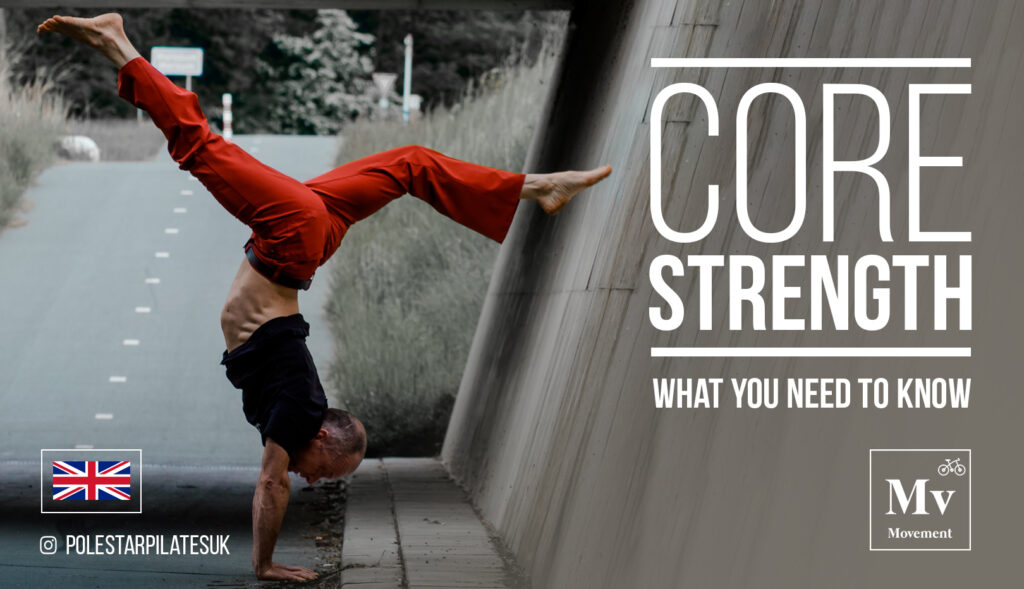
By Kristin Loeer, Movement Therapist & Polestar Pilates Practitioner @polestarpilatesuk
Is core strength your goal from Pilates? This is a goal many of my clients note on their intake form when they come to see me. Not surprising, considering Pilates is considered a discipline that improves core strength. Yet, every time I see “core strength” as a goal, I wonder what it means to the client. Truth is, this goal does not reveal as much as you might think. Here’s what you need to know before you start working on core strength with your clients.
What Is Core Strength?
Believe it or not, core strength is not really a goal by itself. It is a concept, an idea, and a theory about biomechanical function. As a Pilates Teacher, you know all about core strength. Or do you? It is touted as a solution to many problems. A weak core can cause back pain and spinal problems. A strong core helps prevent injury and enables us to master challenging physical tasks. We talk about core strength as though we all agree on what it is. The funny thing is, we really don’t! We can somewhat agree that the core refers to the center of the body, and strength refers to muscular power or force. So let’s work from the basis that core strength comes from the strength of the muscles surrounding the spine in the center of the body.
Hang On, Which Muscles Are Core Muscles?
Many professionals including physical therapists and some Pilates teachers have different views on true core muscles and global trunk muscles. This is where the first problem lies. While for some it is crucial that only four deep muscles of the trunk represent the core, for others it is six, and for others still, it is every muscle surrounding the center of the body. Whichever muscles you consider to compromise the “core” makes a huge difference in how you go about strengthening this area. If you believe it’s the four deep trunk muscles (diaphragm, transverse abdominus, pelvic floor and multifidus), you would use a different strategy than you would if your idea included more superficial muscles.
What we can agree on, is that these deep, postural muscles play a role in stabilizing the spine. As soon as we add movement of the trunk, we also start exercising the global muscles of the trunk. If the core is considered weak, the goal for some would be to strengthen the deep muscles in isolation. You might do minimal-effort stability exercises with no spinal movement. If you believe the core is the body’s center in general, and all muscles in this area play a role in spinal stabilization, you would do more classical abdominal, bracing exercises that feel a lot stronger, or work on a generally more functional level.
What To Believe About Core Strength?
So to assess and prescribe movement effectively, decide what you believe about core strength. How do you make this decision? You could delve more into research on the topic, however, you will find equal parts supporting both theories. I recommend taking a look at the Paul Hodges work for some quality deep core muscle theory, and Stuart Mc Gill’s many books about the reasons behind his abdominal bracing theory. Be ready, you might also come across research that rejects the idea of core muscle strength altogether.
Those who reject it argue that the body does not create stable, healthy movement by contracting individual muscles like pulling strings on a marionette. Rather, movement and stability are created more along the lines of tensegrity, an architectural construct that suspends levers in an equally stretched and tensioned elastic network. So even with all the research and theories on what to believe about core strength and improving it, no one can definitively conclude what we are talking about and what we should be doing.
What Do You Want To Achieve From Core Strength?
There is a time and place for all the different core strength ideas out there. To be effective in our assessment and prescription, you need to start from what you want to achieve from core strength. Do you want to eliminate pain? Improve physical ability or performance? Is it about a toned waist? Do you want it because others seem to? What do you really want to achieve from core strength? And do you really need it? The answers to these questions will give you a much better idea of the approach. The rest comes from observing movements, so you can see if and how the lack of core strength presents in the body. Such a deficit may present itself in different ways, which influences your approach.
What It Means to Lack Core Control
To understand what it means to lack core control, I start from the premise that no one body part is more important than another. Our bodies have developed over thousands of years to be durable and efficient, with no flaws in the design. For varying reasons like sedentary life habits or medical history, some people lack core control. Core control refers to the efficiency and appropriate stability of the trunk during movement. Motor control is the coordination and stability of efficient movement patterns, facilitated by the nervous system. Both may impact spinal health or abilities. However the reason for this lack of core control is unique to each person, therefore your strategy to improve must be unique too.
How to Influence and Improve Core Control
There are so many ways to influence and improve core control. Connective tissue experts like Thomas Myers and Robert Schleip have helped increase awareness of the degree of interconnectedness of the body. Connective tissue, or fascia, interwebs our muscles, organs, and bones from foot to brain. The idea that we should isolate one or few muscles by trying to contract them individually and locally, is unrealistic and according to the research, unnatural. Sometimes we may lack core control because of a local weakness or injury, but how are we going to work a muscle in isolation that is entirely inter-webbed with others? We can use the inter-webbed structures in our bodies to improve core control. To do this, it helps to reflect on how we first learned to move and control our center of gravity; it started with crawling and walking.
We engaged with our environment. We used the feedback we got from the floor, from gravity, and from furniture we leveraged to pull ourselves up. It makes sense to apply the same strategies to maintain and improve core control at any stage of life. Think of it as re-engaging with our natural instincts to learn how to move well. The Pilates apparatus, such as the reformer, trapeze table and combo chair are fantastic tools for this. The machine gives you a unique experience of movement. It gives you subtle resistance and support. It provides feedback while enriching the neurological connections into your muscles. It lets you explore movements in different relations to gravity.
Goals in Pilates
Whatever is aiding core control inside your body is getting lots of stimulation here. It is a Pilates teacher’s job to not only guide movements with the use of machines but to observe the quality of clients’ movements in all areas of their body. Look out for the alignment of lower extremities, the head, neck and shoulder organization, and the articulation and control of the spine. All of this is valuable information about core control ability as well as the many other elements that play a role in healthy physical movement ability.
Core strength, if it exists, is not a one-size-fits-all solution. Start with what your client wants to achieve, and what they want their body to be able to do. What do they want to change, and what will life look like when they achieve it? Some idea of core strength might indeed come into play. But it will be unique to that client and their goals. I hope these insights will help you come closer to understanding and achieving core strength goals for you and your clients.
Author: Kristin Loeer, Movement Therapist & Polestar Pilates Practitioner. Ready to Learn More? Try our Pilates Hour Episode “The Science and Myth of Intra-Abdominal Pressure”.




